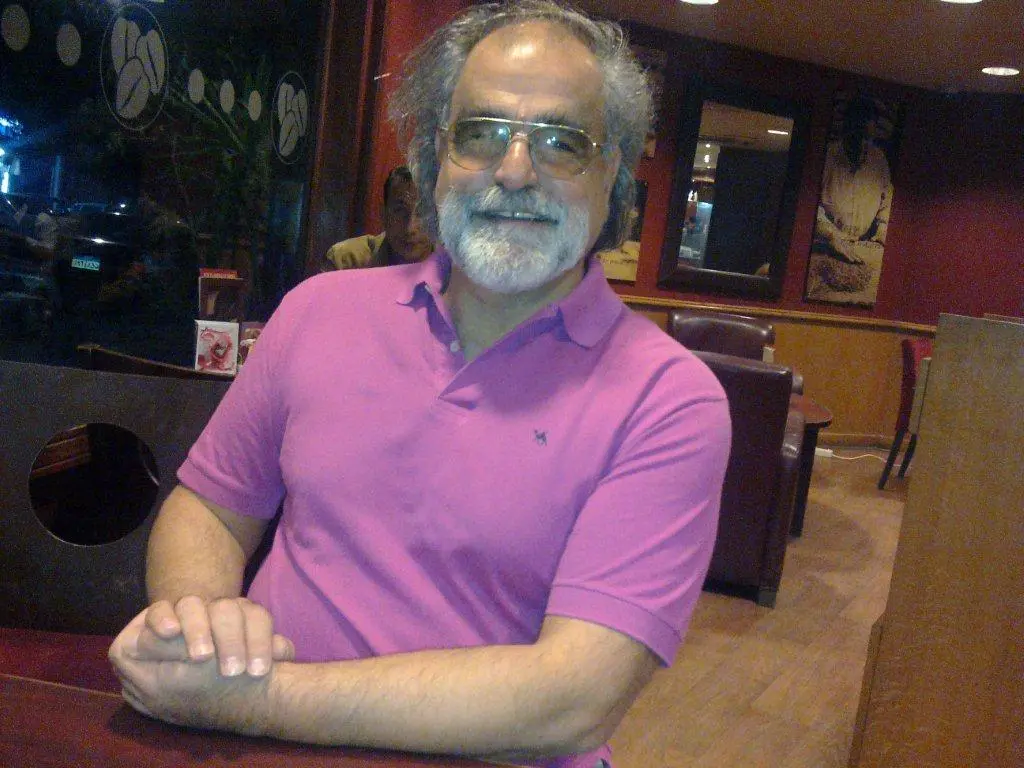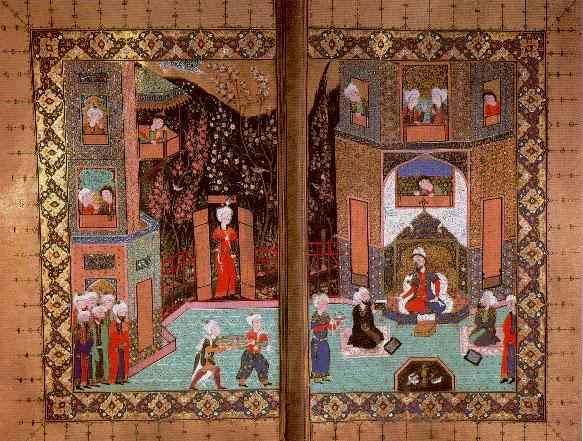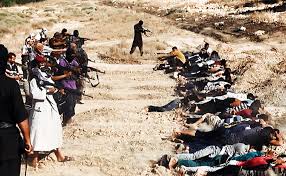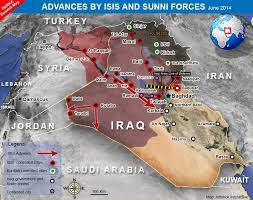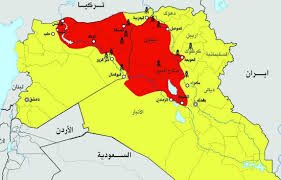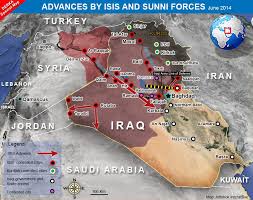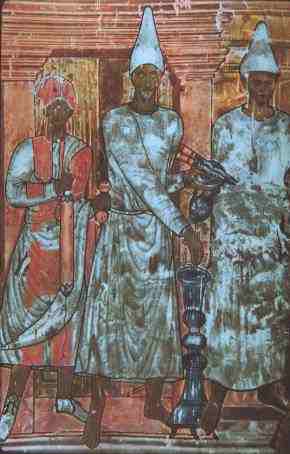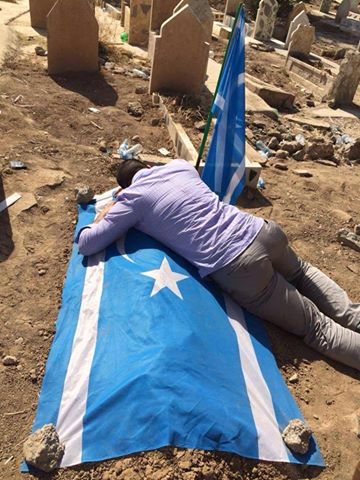How Historical Falsifications Go Viral
By Prof. Muhammad Shamsaddin Megalommatis
Ancient Medes, their Precarious Empire, and the Historical Truth
Few remember today the Ancient Medes, one of the Iranian nations that rose to prominence in the Ancient Orient when, making an alliance with the Babylonian King Nebuchadnezzar, managed to eliminate the few remaining Assyrian garrisons from the abandoned heartland of the Assyrian Empire and, with his Babylonian ally, divide the greatest empire that had grown in the then 2500 years old History of the Mankind. The Median Empire flourished under king Cyaxares (625 – 585 BCE), known as Umakishtar to Assyrians and Babylonians and as Uvak-shatra to Medes and Persians; today, his name in English is derived from the Ancient Greek deformation of the Assyrian-Babylonian name.
Modern maps reflecting political needs of the colonial powers are the result of the forgery of Freemasonic and Zionist Orientalists, who are payed (: bribed) to write what is convenient for those who spread animosity, enmity, fratricidal wars, and bloody conflicts; that’s why these maps show a huge empire of Media stretching from today’s Central Turkey to …. Kyrgyzstan ( ! ). These maps are entirely false. Media was smaller than Babylonia. It certainly spanned from Central Turkey to Central Iran, but neither Fars (today’s Iran’s south) nor Khorasan (today’s Iran’s northeast) were controlled by Cyaxares – let alone territories further to the east.
Map forgery carried out to portray the Median Empire more than double of what its was in historical reality
Made by paranoid, hysterical and heinous pseudo-Christians, Zionists and Freemasons – who quite shamefully revile personally, and fill their sick hearts with great hatred against, the illustrious Babylonian King Nebuchadnezzar who turned the tiny and worthless state of Judah to ashes, transporting its entire population captive to Babylonia -, these fake maps only help these pseudo-Christians implement their odium by dramatically reducing the demarcated Babylonian borderlines as much as possible ( !! ). It sounds childish and sick, but it is true; these forgers of Ancient Oriental History do therefore their ingenious best to deliver a minimalistic view of Babylonia stretching only between today’s southern Iraq and Palestine. That’s absolutely false and totally ridiculous.
The last (and weakest) Babylonian king Nabonidus’ second palace was located nowhere else than in Tayma, an oasis not far from Yathribu, which is the Assyrian-Babylonian name of Yathrib, the pre-Islamic name of Medina. In fact, it was not a matter of the last Babylonian King. For almost two centuries before Nabonidus, the successive Assyrian Sargonid Emperors and Babylonian Nabonid Kings controlled the northern half of the Arabian Peninsula and received tribute from the vassal Yemenite states of the peninsula’s southern.
This is a brief excerpt from a scholarly, albeit summarizing, presentation of the archaeological evidence in Aramaic (administrative language of the Neo-Babylonian kingdom) that was unearthed in the area:
“Aramaic was probably introduced into North Arabia as an official written language by the last king of Babylon, Nabonidus. In 553 BC, he conquered Taymāʾ, Dadan (modern al-ʿUlā), Yathrib (modern Medina) and three other oases on the frankincense route and stayed at Taymāʾ for 10 years. Since Imperial (or Official) Aramaic was the administrative language of the Neo-Babylonian empire, it would almost certainly have been used by Nabonidus’ officials in Taymāʾ, though we know that some of them could also write in Taymanitic, and some fragmentary cuneiform inscriptions from this period have also been found in the excavations. After Nabonidus returned to Babylon in 543 BC, it appears that Imperial Aramaic remained one of the written languages at Taymāʾ and seems gradually to have displaced Taymanitic”. (from: OCIANA – Online Corpus of the Inscriptions of Ancient North Arabia / .
Introductory readings can be found here: / / /
To continue about Cyaxares, we know quite well that his capital was located at Ecbatana (Hangmatana in Old Achaemenid Persian), which is today’s Hamadan (NW Iran), and that the Median capital was protected by seven concentric walls. However, the Medes were a very small people, and the fact that they controlled an already large (for their capacities) territory did not bode well for the future of the newly risen kingdom. Their homeland constituted a minimal portion of the territory they controlled, and north of Media was located Atropatene (Azerbaijan) that stretched from the Middle Zagros Mountains to Caucasus and the Caspian Sea. With a multitude of nations under their control in Anatolia (today’s Turkey) in the west and with a rising strong Persian kingdom in the southeast of their country, the Medes could not last long due to the total lack of homogeneity in their territory, and to the weakness of their traditions. When Cyaxares died fighting against Lydia in the west, it became clear that the days of Media were numbered.
And truly, few decades later, Cyaxares’ granddaughter Mandane’s son, the Persian King Kurosh (Cyrus) – thanks to the mixed marriage of his father – united once forever Media and Persia (550 BCE), only to subsequently add other Iranian plateau territories (through suppression of minor rulers), Eastern Anatolia (already a Median territory), the kingdom of Lydia (Western Anatolia), and more importantly, Babylonia itself in 539 BCE. There is an enormous literature available in different ancient sources (Babylonian, Old Achaemenid Persian, Ancient Greek, Latin, Hebrew) about Cyrus whereby historical truth is perplexedly intertwined with legends, involving a great deal of eulogy and mythologizing. But the Median Empire’s only posterior memory is to be retraced in the the Achaemenid Persian Empire of Iran. The Ancient Greeks may have called their wars with the Iranian Empire (which are today conventionally called ‘the Greco-Persian Wars’) ‘τά Μηδικά’ (the Median affairs), but in reality, there were only few thousands of Medes fighting in South Balkan lands in the early 5th c. BCE.
There has not been found even one inscription in Median language thus far, and it is quite possible that the mother tongue of king Cyaxares was actually never written. The only pre-Achaemenid inscription unearthed thus far is written in Assyrian-Babylonian cuneiform, which is quite normal because the western half of Iran was integral part of the Sargonid Empire (722 – 609 BCE) at least until the end of Ashurbanipal’s reign (669 – 625). What is reconstructed by modern linguists, epigraphists, philologists and historians as Median language is just a list of unusual occurrences in Old Achaemenid Persian inscriptions that are considered loanwords from the Median.
This is the brief diagram of the historical reality as known to us through an objective, neutral, and unbiased reconstruction of the Antiquity on the basis of philological and archaeological evidence.
Ancient Medes: totally Unrelated to Different Modern Nations that have been criminally Baptized as ‘Kurds’
Now from this point up to making of Cyaxares the …. ancestor of many – different from one another – nations that live today from Zagros Mountains (in the borders between Iran and Iraq) to the eastern plains of Syria to the Antitaurus Mountains (SE Turkey) there is as much distance as between the serious and the ridiculous.
In a previous article and video-presentation (https://www.turkishnews.com/en/content/2014/09/07/there-is-no-kurdish-nation-it-is-a-freemasonic-colonial-orientalist-hoax/ – https://www.turkishnews.com/en/content/2014/09/19/there-is-no-kurdish-nation-unmasking-an-orientalist-fabrication-able-only-to-generate-conflicts/ –
I demonstrated that there is no Kurdish Nation, and that the collective appellation, which has been given in Arabic (Akrad) to the – different from one another nations – that live in the aforementioned geographical area, and which is translated in Modern English as ‘Kurds’, cannot be considered as the ethnic name of one nation, due to the tremendous racial, linguistic, religious, and cultural differences that exist among the different ethno-religious entities regrouped under this appellation.
The vicious plan providing for a state named ‘Kurdistan’ was conceived by French, English and American Orientalists, and other Freemasonic agents, politicians and diplomats, and the entire preparation has lasted decades. In the process, for the fake nation, a fake historicity was sought after, and the result ended with the usurpation of the Median past and heritage, which was conveniently and suitably attributed to the past-less ‘Kurds’, who certainly cannot have one common past and heritage, because they are not one nation but many.
Even worse, all these different modern nations (Kurmanji, Zaza, Sorani, Gorani, Hawrami, Faili, Yazidi, Ahl-e Haq to name only the major ethno-religious groups among those who are fallaciously named ‘Kurds’) do not have written monuments in their respective languages (which are of course different from one another) that go beyond 500-600 years. Before that level, all these modern nations are known through very few references in other languages (Arabic, Farsi, Turkish, Azeri, Armenian, Syriac Aramaic, Georgian), but the scarce textual evidence is not enough to duly reconstruct their past. Earlier mentions in ancient languages (Latin, Ancient Greek, Old Achaemenid Persian, and even Assyrian-Babylonian) are even scarcer and cannot help us understand whether they all refer to the same ethnic group or different.
We cannot conclude whether the Assyrian-Babylonian ‘Zikurtu’, the Old Achaemenid Persian ‘Asagartiya’, the Ancient Greek ‘Kardouhoi’, the Ancient Roman ‘Cyrtii’ and the land known as Gordyene in Ancient Greek and Latin have anything to do
- with one another, and/or
- with one of the modern Kurmanji, Zaza, Sorani, Gorani, Hawrami, and Faili – the main ethno-linguistic groups that are mistakenly called altogether as ‘Kurds’.
Attributing to these disparate ethnic elements an almost totally undocumented past (the Median heritage) is purely absurd and testifies only to extremely vicious and even criminal needs of distortion and falsification. In fact, the Medes did not have any posteriority after the end of the Achaemenid Empire and its substitution by the ephemeral empire of Alexander the Great. The term ‘Media’ was shrunken into a merely geographic description; the Medes were certainly assimilated to the Atropatene Azeris and/or to Persians, and no Median cultural identity can be traced in any possible way during the subsequent periods of Seleucid (312 – 63 BCE), Arsacid (250 BCE – 224 CE) and Sassanid (224 – 651 CE) rule.
The Ludicrous Usurpation of the Median Past by bogus-Kurdish Nationalists – agents of the Intelligence Service
The story of this purely childish effort can make every saddened heart explode in laughter. At the very beginning of the falsehood about a hypothetical connection between the extinct ancient nation of the Medes and the non existent nation of the ‘Kurds’, one finds an unfortunate Iraqi Sorani young man who died under mysterious circumstances (most probably assassinated by the English secret services because he knew ‘too much’ of their internships and projects, while failing to keep his mouth closed) and in very young age and after never having studied History. This is Yûnis Reuf (1918–1948), who is widely known through his pen name Dildar (an Indian name that no Sorani Iraqi would have ever imagined to use it for himself because simply no one knew in Iraq this name at that time – and actually before being used as pen name, this name was his code name among the English secret services agents and diplomats who were those who made the name known to his silly bearer). Yûnis Reuf was a naive, idealistic, enthusiastic, daydreaming, and rather romantic youngster who failed to identify the criminal minds and the heinous hearts that were hidden behind the smiley faces of the Baghdad-based English gangsters, i.e. all those who befriended him for a while (before poisoning him and only after they extracted from him what they intended to duly utilize for their ignominious purposes). Born in Koy Sanjaq, near Suleymaniyeh, ‘Dildar’ studied Law in Baghdad, and there he was picked up by the English agents who used to include in their payroll youngsters originating from different ethnic background as tools for their nefarious and evil colonial rule that brought about the destruction that we have attested in the ancient land of Mesopotamia over the past decades.
During the period he is referred to as imprisoned ), he was in fact interned, and then he attended various seminars offered to duly selected audience by distinct members of the perfidious and criminal, colonial elite including Max Mallowan, the Assyriologist and archaeologist who happened also to be the husband of Agatha Christie.
During this process of falsehood indoctrination (I should say intoxication), he was told all the irrelevant points of which he made the cornerstones of his misplaced, baseless and futile ‘nationalism’. Ideas of a ‘Kurdish’ past related to the Medes (of whom he had never heard before) were deleteriously instilled into his ignorant mind, while his youthful and innocent enthusiasm was criminally exploited in a way to make him deliver in Sorani poetry what the English wanted the Soranis to be stupid enough to believe.
The rest was easy. ‘Dildar’ composed in Sorani (there is no ‘Kurdish’ language) the silly and heinous pseudo-poem Ey Reqib, and his colonial masters – happy that after 20 years of murderous, illegal presence on Ottoman territory they had in their dirty hands at last a useful document written by a naive, idiotic and therefore easily manipulated local youngster – managed within no time that the ‘poem’ was accepted by their other ‘Kurdish’ stooges as a ‘national anthem’ of the bogus-Kurdish nation that they intended to create. More about the fake anthem of the bogus nation can be read here:
Simple philological analysis can prove that the ‘poem’ is not a normal national anthem. National anthems reflect the identity of one nation or the aspiration of one people at a particular moment. In striking contradiction with what a national anthem is or can be, this ‘poem’ defines the supposed nation for which it is written as per their imaginary opponent! Ey Reqib (which is both the title and the first verse) in Sorani means ‘oh enemy’. The pathetic verses of the pseudo-poem constitute a series of affirmations so viciously Freemasonic of content that certainly not one Sorani, Gorani, Zaza, Kurmanji, etc. would dare accept. Through English treachery, mendacity, and perfidy, people who have nothing in common as ethno-religious groups are made to believe that (as one verse states) “Kurdistan is our religion”. This is a shame and an abomination for every Muslim, Yazidi or Ahl-e Haq (the main religions among all these different nations of which the villainous gangsters of the Freemasonic lodges intend to make one monstrous ‘Kurdish’ fabrication).
In the worthless text, which comprises of just 20 verses, the sentences “Let no one say Kurds are dead, they are living. They live and never shall we lower our flag” are repeated five times, being thus half of the rather short ‘anthem’!
However, in the fourth stanza, it is stated in Sorani that “Ême roley Mîdya u Keyxusrewîn”. This is the first time the word Mîdya is written or said in Sorani, because no local had studied Orientalism and Iranology until that time in order to come across with this ancient nation which is not mentioned in Arabic, Farsi, Turkish and Azeri literature – let alone the literature of the indigenous Sorani, Gorani, Zaza, Kurmanji, etc.
It is really cute to notice that the naive boy that composed the worthless verse did not even bother to localize in his native language the previously unknown to him, English name of the ancient kingdom, and so ‘Media’ was merely transliterated into Mîdya without the slightest effort of an eventual localization – Midistan, etc.!
Translated in English, this verse reads: “We are the descendants of Media and Keykhosrow”. However, in the conventionally accepted and diffused, false English translation of the Sorani verse, ‘Media’ is replaced by ‘Medes’. This is an enormous falsification, because ‘the descendents of Media’ can mean in general the heirs of earlier civilizations developed by other nations on the same land, which poses no problem as it can be a normal case of cultural historicity. Quite contrarily to this, the false translation presents today’s bogus-Kurds as the offspring of the Ancient Medes, which is absolutely wrong and absurd.
What is really comical as falsification and, at the same time, demonstrates how fake the whole effort is can be attested in the false translation of the verse’s last word, e.g, the name Keykhosrow (‘Keyxusrewîn’).
Who is Keykhosrow?
Conventionally written in English as Kai Khosrow or Kay Khosrow, the legendary king is attested in Iranian and Azeri literature that goes as back as the 10th c. CE and reflects views over the origins of the Central Asiatic civilization, namely an heroic era of mythical kings, of their deeds of their and exploits, at a historically undefined time, when prevalence, superiority and sovereignty was vindicated by both, Turks and Persians, who – according to the narrative – are in fact the offspring of the same royal family.
Certainly, this heroic king’s name was not invented in the 10th c. CE as it is attested in earlier texts and even in the Avesta. But the Avestan term Kavi Husravah does not mean any legendary king but the ideal, primordial concept of fame. In other words, within different religious-cultural backgrounds the same name takes diverse connotations – Zoroastrian, Zendist, Mazdeist, etc., and the latest connotation is the Islamic Iranian one within which the earlier concept of fame is merely personified as a famous king.
Reading and interpreting epic poems like the famous Shahname by Ferdowsi (10th c. CE) is totally out of the limits of the present article, but here we have to stress the point that there are several different compositions and narratives of the same epic circle and they all reflect varied interpretations, Azeri / Turkic or Persian, of the common, Central Asiatic heritage and past that these nations had recorded to have had. One must add at this point that the epic circle in and by itself demolishes the modern linguists’ long venerated assumption of a division between two distinct ethno-linguistic groups, namely the Indo-European and the Uralo-Altaic (or Turco-Mongolian); however, this is a different topic.
On the other hand, one must specify that the consideration of ‘Iran’ as a matter of Persian history, homeland, nation, language, culture and civilization is only the result of Western Orientalist and Iranologist biases. Of course, this forgery was subsequently utilized by Persian nationalists, who turned the Iranian Empire into a nationalist monarchy under the pseudo-dynasty of Pahlavi, but this consists in a typical nationalistic nonsense. Iran is equally Azeri / Turkic and Persian, and the full proof for this is demonstrated by the fact that several Seljuk (Turkish) Sultans were also named Kay Khosrow. In fact, different narratives and diverse interpretations of the same heroic era heritage were equally appropriated by Azeris / Turks and Persians.
About the legendary king, introductory information can be found here: / http://www.cais-soas.com/CAIS/Literature/Shahnameh/keykhosrow.htm
About the three Seljuk Turkish historical kings, basic info can be read here: / /
A last point that I would like to add to the aforementioned is that it is not only for the name Kay Khosrow that a) the aforementioned set of the existing different connotations as per diverse religious context and b) the Azeri / Turkish – Persian polarization can be encountered. Other names, like Kay Kaus, Kay Qubad, etc. present respective parallels at both levels, a and b – each involving several different connotations (Zoroastrian, Zendist, Mazdeist, etc.) and the said polarization.
– What is the relation that Kay Khosrow may have with the Soranis and the other nations that the Western colonial forgers regroup under the name of ‘Kurds’?
– Ethnically – racially none, but culturally great!
The mention of Kay Khosrow in the few childish verses composed by ‘Dildar’ to be selected by the English colonials, and by their idiotic pseudo-‘Kurdish’ stooges, as ‘Kurdish’ national anthem (Ey Reqib) reveals only the following points:
1- there was a tremendous cultural impact, exercised on two axes, namely a) Seljuk – Ottoman (Turkish) over the Kurmanji and the Zaza and b) Timurid – Safavid – Afhar – Zend – Qajar (Iranian, so partly Persian and partly Azeri / Turkish) over the Sorani and the Gorani
2- there was a sheer identification of the diverse small nations (that today’s colonials attempt to portray them as one and independent ‘Kurdish’ nation) with the common Turkish – Azeri – Iranian historical and mythical national background,
3- there was an evident overwhelming appropriation of Turkish – Azeri – Iranian concepts, values and virtues, ideals, prototypes and paradigms for the social-behavioral and cultural life’s needs of these marginal mountainous nations that did not have a significant heritage of their own, and
4- Turkish – Azeri – Iranian concepts, values and virtues, ideals, prototypes and paradigms prevailed even in the minds of those selected in Iraq by the English colonials as their own tools as recently as the middle of the 20th c.
Now, it is high time for me to unveil why I started my article by expanding briefly on Cyaxares, the only significant king of the Ancient Medes. The reason is that the UK-US bribed, fake Kurdish gangsters, who – in Iraq, Syria, Turkey and Iran – promote the fake Kurdish nationalism and demand an independent Kurdistan, have been ‘taught’ by their secret Western masters to posture as the descendents of Cyaxares!
– What is their proof?
The false English translation of the verse of the fake national anthem Ey Reqîb that refers to Kay Khosrow!
The Sorani verse “Ême roley Mîdya u Keyxusrewîn” was falsely translated in English as “We are the descendants of the Medes and Cyaxares” (see Wikipedia link above), and this is presented by the idiotic thugs of the fake Kurdish nationalism, the likes of Talabani and Barzani, as the ‘proof’ of their supposedly Median ancestry.
Why do I specify that these idiotic thugs and gangsters have been taught all this fallacious nonsense by their Freemasonic / Zionist masters?
Simply because not one Sorani or Kurmanji specialized in Old Achaemenid Persian (cuneiform), Ancient Greek, Latin and Hebrew to have thus direct access to original sources and subsequently form a correct view of the specific historical period to which it is impossible to establish any link for themselves and their resolutely non-Median past.
All the bribed fake Kurdish nationalists repeat therefore the lies and the falsehood that the incestuous Freemasonic tyrants, diplomats and agents of France, England, Holland, Canada, America and Australia and the inhuman beasts of the fake, Anti-Jewish state of Israel order them to say, although it is very well known that all their instructions are false and that ‘Key Khosrow’ cannot possibly be translated as ‘Cyaxares’!
Fake Christians propagating the Anti-Christian, Satanic Falsehood
It would however be wrong to imagine that the pathetic and ignorant fake Kurdish thugs are the only victims to have been misled and deceived through the Satanic poison that the Anti-Christian rulers of the Freemasonic – Zionist tyrannies of the West have systematically and incessantly diffused. There are many millions of Western fake Christians who are equally or even worse victimized. How? By unquestionably accepting the aforementioned falsehood as truth and by trying to adjust it to their evil ministries and childish teachings.
Scores of ‘pastors’, ‘ministers’ and other ignorant commentators – of all sorts of heretical backgrounds involving Protestant, Evangelical, Baptist, Anabaptist, Pentecostal, Methodist and other villainous deviations – ‘inform’ their supposedly Christian, but genuinely unsuspicious, naive and gullible readership about the plans of their criminal and Satanic elites that these pseudo-Christian ‘ministers’ serve by deceitfully presenting these plans as godly of origin (which is a foremost sin) and as supposedly prophesied across their misinterpreted Bibles!
Their followers, all those who accept the filthy scam, are being used by the ruling Freemasonic – Zionist, Satanic elites of America, France, England and their allies. By accepting this falsehood, sizable Christian populations are demotivated from scrupulously examining the Christian or Anti-Christian character of their rulers’ deeds, plans and policies and thus remain inactivated, pathetic and lethargic, which in turn eliminates obstacles and reactions from the path of their rulers towards establishing a global Satanic state of falsehood and distortion.
Even worse, the devilish ‘pastors’ and ‘ministers’, by identifying the Satanic policies and deeds of the Western rulers with supposedly Biblical prophecies and with the will of God, force their followers into slavery and submission to Satan, as they – by rejecting the historical truth and deeply plunging into ignorance – directly oppose Jesus’ order “Γνώσεσθε τὴν ἀλήθειαν, καὶ ἡ ἀλήθεια ἐλευθερώσει ὑμᾶς” (Vulgata: “et cognoscetis veritatem et veritas liberabit vos” / English: And shall know the truth, and the truth shall make you free – from John 8:32).
You probably don’t know Jack Kelley; you certainly don’t miss much. This ignorant and uneducated person found it necessary to compose a nonsensical article under title ‘The Return of the Medes’ ). The article starts with a fake map of an otherwise non existent country, ‘Kurdistan’. Not even in their wildest dreams did the fake Kurdish thugs and gangsters (who are closely guided controlled by the Satanic organizations CIA and the Mossad) dare to imagine that such a big bone would be thrown to them! Fake, non-existent Kurdistan is depicted in extraordinary dimensions on this forged map in order to look as vast as the precarious Median Empire!
Map forgery included in the ridiculous, false article published by the False Prophet Jack Kelley
Do you know what exactly the Anti-Christian gangster Jack Kelley does by suggesting the formation of a fake this big?
He heralds the butchery of the Oriental Christians of Urumiyeh, Salmas, Miandoab and other locations in Iran who are presented as forthcoming subjects of the fake Kurdish state, since all these cities and the surrounding territories of the Iranian provinces of West and East Azerbaijan have been included in the fictional state that Jack Kelley’s criminal masters want to set up. To serve his Satanic masters, the inhuman beasts of the CIA and the Mossad, this false preacher does not give a damn about the fate of the true Christians – which in and by itself is the best proof that he is a Satanist impersonating the Christian priest. I can already see Aramaean Christian blood in Jack Kelley’s hands because, if such an evil state is formed, the Christians will be the first targeted by the fake Kurdish nationalists and their lawless militias.
This silly person, who never attended the first hour of a first year course in History of Ancient Iran, repeats the hereby refuted falsehood of the Median ancestry of the non-existent Kurdish nation (“The Kurds are the modern descendants of the Medes”) in his trashy text, which is full of stupid mistakes, nonsensical assumptions, and deliberate distortions. In fact, every line of his text is full of mistakes.
Example: “The Medes, an Indo-European people who were joined by the Persians in their successful effort to overthrow Babylon and establish themselves as a world power in the 6th century BC”!
This pathetic and dangerous liar ignores that the Medes were not joined by the Persians in any effort against Babylon, simply because the Persians merged with Media by means of mixed royal marriage of Cyrus’ father, and that the unification of the two kingdoms (Media and Persia) took place more than a decade before Iran attacked Babylonia.
Why does this ludicrous Kelley man want to desperately include the Medes in the invasion of Babylonia which was undertaken exclusively by the Persians under Cyrus? The reason is simple. The Western pseudo-Christians’ and Satanists’ ‘art’ of impressing innocent and naive Western Christian readership involves the establishment of parallels between a misinterpreted past and a falsely prophesied future. Scores of villainous gangsters, who incessantly, purposefully and mercilessly kill Christians’ souls – through lies, systematic falsehood, and multilevel deception – insist on ‘inventing’ prophetic parallels in past events and teach their otherwise unsophisticated audiences that what happened in the past was an archetypal form of crucial events that ‘will’ happen at the End of Times. In fact, they commit a double forgery; they misinterpret several excerpts from prophetic – apocalyptic texts, then they deliberately falsify the past events as per their needs, and at the end, they establish the parallelism, thus uttering their bogus prophecies!
Concerning the ludicrous assumption of a double Median-Kurdish (past and future) Anti-Babylonian action, Jack Kelley’s paranoid forgery involves the following 3-step argumentation and the ensuing conclusion:
- The Medes overthrew Babylonia (which is proven wrong).
- The Medes are the ancestors of the ‘Kurds’ (which is proven wrong).
- So, the ‘Kurds’ will overthrow Babylonia at the End of Time.
– That’s why the West should help ‘Kurds’ setup their state, so that they later overthrow …. Babylonia (that does not exist anymore, but the idiotic author makes a laughable effort to resuscitate it!!).
What does Jack Kelley does not say?
He does not confess that he intends to write another ‘article’ in the future, and similarly ‘prove’ to his unfortunate readership that today’s ‘Babylonia’ is Islam or Turkey or Saudi Arabia and that the ‘allegorical’ notion of the Biblical term has been meanwhile ( ! ? ) transferred to Istanbul, Medina, Mecca or any other place whereby his shadowy masters and payers may order him to locate it!!
So, unrelated to the Medes and non-existent as one nation, the fake Kurds are ‘prophesied’ by this vicious liar to become “God’s agency for the never before fulfilled judgment against Babylon at the End of the Age”. And although ‘Babylon’ is a metaphor within Biblical and Christian prophetic texts (so, totally unrelated to any possible ‘state’, past or future), the miserable and idiotic liar Jack Kelley tries to identify it with the location of the ancient Mesopotamian city!!
This is a brief part of his toxic text: “Those who say the restoration of Babylon will require billions of dollars and many years have not considered that its preparation has been under way for several years now. For example, if you take a close look at the dimensions and capabilities of the US embassy in Baghdad you will see how easily it could be converted into a world governmental headquarters. With a compound covering 104 acres, it is the largest and most expensive embassy in the world, and is nearly as large as Vatican City. Babylon is only about an hour away by car.
In addition, one of Saddam Hussein’s palaces sits on a hill overlooking ancient Babylon and has been completely restored as a hotel and tourist destination. It could easily house the anti-Christ and his entourage. And there are several large military installations nearby as well. In short, preparing Babylon to become the capitol of the world won’t take anywhere near as long as most people think. And remember, this is Satan’s city on Earth”.
Do you want to know how it will all end?
False Prophet Jack Kelley has it ready for you in his McDonald’s style ‘prophecy’: “Through the Kurds, the Medes have stepped out of history and onto the world stage once again, and another player in the End Times Scenario is taking its place. One day soon, the King of the Medes will again lead a vast army against Babylon, and this time her destruction will be complete, and the Lord’s words will be fulfilled”. Absolute nonsense and deliberate forgery for which Jack Kelley will be deservedly thrown in the bottomless pit.
So, now you understand that, when you read in Matthew 24:4 “Βλέπετε μή τις ὑμᾶς πλανήσῃ” (Vulgata: “videte ne seducamini ” – English: See that no one mislead you), you know that Christians have already been ordered to reject the vicious fallacy of Jack Kelley.
Where does Jack Kelley’s mistake lie?
His reading of the Biblical and Christian texts is very superficial, schematic, immoralist and materialistic. He views these texts, which are above all reflecting moral standards and principles, eternal values and virtues, as simple mechanical tools able to be adjusted to his dirty heart’s vicious plans and desires that are all materialistic of nature. There is no spirituality and there is no morality in the Biblical texts in the way he reads them. I will terminate my article with an example. His worthless text starts with a Biblical excerpt referring to the Ancient Medes (the true ones, who are unrelated to today’s fake Kurds).
This is the Biblical text’s English translation that he has chosen: “See, I will stir up against them the Medes, who do not care for silver and have no delight in gold. Their bows will strike down the young men; they will have no mercy on infants nor will they look with compassion on children. Babylon, the jewel of kingdoms, the glory of the Babylonians’ pride, will be overthrown by God like Sodom and Gomorrah. She will never be inhabited or lived in through all generations; no Arab will pitch his tent there, no shepherd will rest his flocks there”. (Isaiah 13:17-20)
This text should not be taken as historically wrong because it mentions Medes and not Persians destroying Babylon; the selection of the ethnic names by scribes, translators and copyists in the Antiquity reveals several times a preference for a certain archaic style, and one has to take into consideration that the Septuagint (the 72 scholars), who translated from Biblical Hebrew to Ancient Greek the Hebrew Bible (Old Testament), delivered their work to Pharaoh Ptolemy II in Alexandria 250 years after the Persian invasion of Babylonia (539 BCE). Even more so because the Achaemenid Empire of Cyrus had already ceased to exist in their time, following the conquests of Alexander the Great that took place at least 50 years before the Jewish scholars traveled to the Mediterranean city where they worked on this project in a royal facility made available to them at the island of Pharos.
However, the first sentence of the text is a key for us to understand the moral standards involved in Hebrew god’s decision to use a nation against another as chastisement. The Medes, as per the text, “do not care for silver and have no delight in gold”. This sets a very specific contextualization of how things like that can happen. The Medes are described as fully disinterested in materialistic goods, because even the two most precious metals of those days did not attract their attention.
This irrevocably concludes the case of the corrupt mind and worthless text of the False Prophet Jack Kelley. Even if today’s fake nation of the so-called ‘Kurds’ had been a true nation (and not a collective appellation of many different nations that evil colonial interests want to put together in the next ‘fratricidal’ scheme), even if today’s ‘Kurds’ as a hypothetically one nation had been the latest offspring of the Ancient nation of the Medes (which is certainly not the case), today’s ‘Kurds’ – in order to be eventually used again by the Hebrew god for the role that the ignorant author pretends that they will play – would have obligatorily reflected the same moral principles, concepts, values and virtues as those attributed by the Biblical text to the Ancient Medes (meant by the Septuagint translators as ‘Persians’).
Anyone who lives in our world knows that the fake Kurdish nationalists and their thuggish leaders, who are the puppets of France, England, America and Israel, are lewd and villainous persons of exclusively materialist interests of the lowest sort. These are the gangsters who killed scores of Iraqi Turkmen in order to ensure some millions of petrodollars for their filthy bank accounts and disreputable pockets. These are the inhuman beasts who can let others (particularly the Christian Aramaeans) die if this is the way their Satanic masters order them to act (they did so in Mosul where they had the time to prepare for battle when they first got the news of the ISIS plan – but their CIA / Mossad masters ordered them to abstain from any involvement). These are the masters of corruption, perversion, and lawlessness; they sell drugs wherever they settle and they manage their illegal business of human trafficking which has marked an extraordinary growth over the past 11 years. They feel no moral compunction to perform the most monstrous deeds for a handful of dollars. Only a False Prophet would find in them the tool of his god, but this lower god’s name would be Satan. And the False Messiah that a False Prophet like Jack Kelley expects is only the Antichrist (Masih Dajjal) and none else.
The very bad news for America’s fake Christians and False Prophets is that a genuine interpretation of sacred texts reflecting moral values cannot be undertaken by people who find it normal to live in a genocidal country that has systematically and mercilessly persecuted the indigenous population of the occupied territories for more than two centuries in the most abominable manner.
Truth and Faith do not permit a country to have Wall Street or Federal Reserve. If there are true Christians in America, their only possible target is the immediate rejection of the Satanic tyranny that has been imposed on them and on their forefathers since Day 1 the cursed Freemasonic – Zionist state was incepted.

